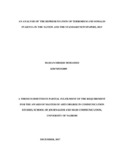| dc.description.abstract | This study analyzed how The Nation and The Standard newspapers in Kenya represented ethnic Somalis in their coverage of terrorism in 2015. The study was motivated by the fact that 2015 was a difficult year in Kenya, with terror incidents occurring in different parts of the country. The study had three objectives; to examine how the mainstream print media in Kenya framed ethnic Somalis in the context of reportage of terror news and analyses, to evaluate trends of associations of ethnic Somalis in Kenya with terrorist activities in mainstream print media in Kenya and, thirdly, to examine the extent to which mainstream media in Kenya drew on ethnic stereotypes in the framing of terrorism reportage and analyses. The research was guided by three major theories, thus the Michael Fairclough‟s Critical Discourse Analysis (CDA) and Erving Goffman‟s Framing Theory. Where needed, the researcher also drew on Stuart Hall‟s Language Theory and the idea of representation, especially the notions of coding and decoding and their implications to meaning and social interactions. The study deployed mixed method approaches as its overarching methodology, triangulating empirical and library-based tools of data collection. There was the use of Key Informant Interviews with editors, other media staff and academics of media and journalism; Focused Group Discussions with opinion leaders associated with Kenyan Somalis; and Library Literature Review. This mixed method approach also informed data analysis and representation of the findings. From all these, the research established that The Nation and The Standard considerably misrepresented ethnic Somalis in the coverage of terrorism. The study noted a tangible presence of several representational elements that negatively framed ethnic Somalis in the articles analyzed. The study concluded that both The Nation and The Standard rely on stereotypes, associations, and Infographics to appeal to the common readers‟ supposed knowledge of terrorism and the presumed role of Kenyan Somalis in the menace. This was done through adversely implicating articles without clear sources, use of sensational quotation and pictures and portraying the community as the villains in the war against terror. Based on these findings, the researcher recommends that a similar study be conducted with regard to other media, particularly social and digital, for purposes of comparison on just how pervasive the phenomenon is currently. | en_US |



